On May 30, 1967, Mazda launched the world’s first twin-rotor rotary-engined car, the Mazda Cosmo Sport. The company now celebrates that engine’s 40th anniversary.
In these past 40 years Mazda has produced nearly 2 million vehicles powered by the rotary engine. It was not until 1970, however, that Mazda sold rotary-engine-equipped cars in the United States. That was the 1970 R100; it was followed by the RX-2, RX-3, RX-4 and RX-5 Cosmo. Incidentally, the 1970s even saw Mazda install the rotary engine in its Rotary Pickup truck.
Through the years, automakers as diverse as General Motors, Daimler-Benz, Rolls-Royce and Citroen have experimented with the Wankel rotary engine, but only Mazda overcame the engineering challenges necessary to bring the engine to market in a mass- production vehicle.
Engine Overhaul
When Mazda launched the now-legendary RX-7 in 1979, it really shook up the sports-car establishment and set sales records never before seen with sports cars. The second generation RX-7 made its debut in 1985, featuring a 13B rotary engine boosted by a Twin-Scroll Turbo. Subsequent RX-7 generations were launched in 1986 and 1993, including the first production applications of turbocharging the rotary engine in the U.S. market. And when the company launched the four-door sports car RX-8 in 2003, the rotary engine saw a dramatic update with the introduction of side porting, resulting in greatly reduced exhaust emissions and improved performance.
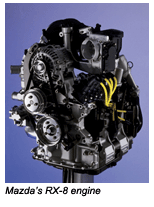 Mazda is now developing its hydrogen RE, which emits no carbon dioxide (CO2). Development started in 1991 and has so far produced the RX-8 Hydrogen RE, which in February 2006 became the world’s first to be commercially leased. Currently, seven are on the road in Japan under commercial lease.
Mazda is now developing its hydrogen RE, which emits no carbon dioxide (CO2). Development started in 1991 and has so far produced the RX-8 Hydrogen RE, which in February 2006 became the world’s first to be commercially leased. Currently, seven are on the road in Japan under commercial lease.
Latest-Generation Rotary Engine — RENESIS
Nearly 40 years of rotary-engine racing success went into the design of the Mazda’s advanced RENESIS (Rotary Engine genesis — or rebirth of the rotary engine) powerplant when it was launched in the RX-8 in 2003.
One of the key factors of RENESIS, is that this new-generation twin-rotor Mazda rotary engine is smaller and lighter than the company’s previous rotary, but produces even more power. Because it has a new side-intake and side-exhaust layout, the engine delivers 250 horsepower at 8,500 rpm and 162 lb.-ft. of torque at 7,500 rpm without the weight and complexity of a turbo- or supercharger, while achieving improved fuel efficiency and cleaner emissions.
The side-intake, side-exhaust layout, with the exhaust ports moved to the side housing of the rotor chamber, allows the size of the ports to be freely set, resulting in an expanded air-intake port area which is 30% larger than in conventional rotary engines. This greatly improves intake resistance and contributes to an output of 250 hp at 8,500 rpm and maximum torque of 162 lb.-ft. at 7,500 rpm without having to rely on a turbo- or supercharger.
In addition, the adoption of dual exhaust ports for each chamber achieves twice the port area of conventional designs and also allows exhaust port timing to be delayed for increased thermal efficiency in the expansion process. Unburned hydrocarbons are retained for combustion in the next cycle, which greatly reduces emissions. A three-stage induction system, featuring shutter valves at the intake ports of each rotor, utilizes the incoming air’s dynamic charge effect and improves filling efficiency, while twin electronic throttles precisely and flexibly control the valve operation. Furthermore, a wet-sump lubrication system with oil-pan height just half that of conventional designs also reduces engine size and weight.
Tackling Environmental Issues
Zero overlap between the intake and exhaust ports results in enhanced thermal efficiency for the RENESIS engine, allowing a much leaner air/fuel mixture for fuel efficiency when idling compared to the 13B-REW rotary engine in the RX-7. In addition, thanks to the efficiency inherent in the rotary engine, the RX-8 operates with a lean mixture even during high-speed, high-load operation.
A high compression ratio and newly developed ultra-fine fuel injectors make virtually perfect combustion possible across the engine’s entire speed range.
Rotary engines also have structural qualities that cause them to generate less NOx (nitrogen oxide) than conventional engines. RENESIS’ side-exhaust layout retains unburned HC (hydrocarbons) for the next combustion cycle, further lowering emissions. In addition, a newly developed catalytic converter for the rotary engine is teamed with a double-skin exhaust manifold that maintains a high exhaust-gas temperature to improve catalyst activation on engine start, even in cold conditions.
Power Loss Problems
In August 2006, Mazda announced that it would recall its 2004, 2005 and some 2006 Mazda RX-8s due to a miscalculation with oil metering of its RENESIS engine.
Mazda reported that this had led to the engines in some RX-8s to experience problems with severe power loss and rough idle, most notably in warm climates and those exposed to high traffic conditions.
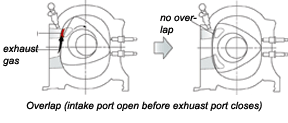 Mazda’s recall allowed the models to be tested for the power-loss problem, and that all engines that failed a vacuum test were replaced at no charge, even if the car was out of warranty.
Mazda’s recall allowed the models to be tested for the power-loss problem, and that all engines that failed a vacuum test were replaced at no charge, even if the car was out of warranty.
The replacement engines also corrected other issues ranging from flooding, hard starting and complete loss of compression. Mazda said that only about 1% of the RENESIS engines needed to be replaced.
However, on all the vehicles that did not require an engine replacement, Mazda said that the ECU was reflashed to provide for more oil injection at idle and under low rpm driving.
Under the recall, the catalytic converter and leading spark plugs were also checked and replaced as needed. Mazda then extended all recalled vehicles’ drivetrain warranty to five years/60,000 miles.
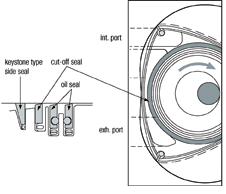 It should be noted here that full synthetic oils should not be used in Mazda rotary engines, which have unique and specific lubrication requirements. Always check the vehicle owner’s manual.
It should be noted here that full synthetic oils should not be used in Mazda rotary engines, which have unique and specific lubrication requirements. Always check the vehicle owner’s manual.
Wankel 101
For technicians who are not familiar with the Wankel engine, the best way to explain a rotary engine design is that it is composed of a cocoon-shaped housing and a triangular-shaped rotor inside of it. The space between the rotor and the housing wall provides the chamber for internal combustion and the pressure of expanding gases serves to turn the rotor. In order to make the rotary engine work as an internal combustion engine, the four processes of intake, compression, combustion and exhaust had to be performed in succession in the working chamber.
Suppose that the triangular-shaped rotor were concentrically placed inside a true circular housing. In this case, the working chamber would not vary in volume as the rotor turned inside the housing. Even if the air/fuel mixture were ignited there, the expansion pressure of combustion gas would merely work toward the center of the rotor and would not result in rotation. That was why the inner periphery of the housing was contoured as a trochoid-shape and assembled with the rotor installed on an eccentric shaft.
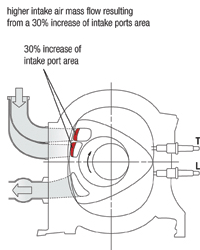 The working chamber changes in volume twice per revolution, thus the four processes of the internal combustion engine could be achieved. With the Wankel rotary engine (named after engine pioneer Dr. Felix Wankel who developed the Wankel-type rotary engine in 1957), the rotor’s apices follow the oval contour of the inner periphery of the engine casing while remaining in contact with the gear on the output shaft, which is also in eccentric orbit around the center point of the engine casing. A phase gear mechanism dictates the orbit of the triangular rotor. The phase gear consists of an inner-toothed gear ring fixed on the inside of the rotor and an outer-toothed gear fixed on an eccentric shaft. If the rotor gear were to have 30 teeth inside it, the shaft gear would have 20 teeth on its perimeter so the gear ratio is 3:2. Due to this gear ratio, the rate of turning speed between the rotor and the shaft is defined as 1:3.
The working chamber changes in volume twice per revolution, thus the four processes of the internal combustion engine could be achieved. With the Wankel rotary engine (named after engine pioneer Dr. Felix Wankel who developed the Wankel-type rotary engine in 1957), the rotor’s apices follow the oval contour of the inner periphery of the engine casing while remaining in contact with the gear on the output shaft, which is also in eccentric orbit around the center point of the engine casing. A phase gear mechanism dictates the orbit of the triangular rotor. The phase gear consists of an inner-toothed gear ring fixed on the inside of the rotor and an outer-toothed gear fixed on an eccentric shaft. If the rotor gear were to have 30 teeth inside it, the shaft gear would have 20 teeth on its perimeter so the gear ratio is 3:2. Due to this gear ratio, the rate of turning speed between the rotor and the shaft is defined as 1:3.
The rotor has a longer rotation period than the eccentric shaft. The rotor rotates one turn while the eccentric shaft rotates three turns. With the engine running at 3,000 rpm, the rotor will run at a mere 1,000 rpm.
A Wankel vs. a Reciprocating Engine
In order to get the turning force, both the reciprocating engine and the rotary engine rely on the expansion pressure created by the combustion of the air/fuel mixture. The difference between the mechanisms of the two engines is in the way that the expansion pressure is used. In the reciprocating engine, the expansion pressure generated above the piston’s top surface forces the piston down and the mechanical force is transferred to the connecting rod that causes rotation of the crankshaft. In the case of the rotary engine, however, expansion pressure is applied to the flank of the rotor.
One of the three sides of a triangle is forced toward the center of the eccentric shaft as a result. This movement consists of two divided forces. One being the force toward the output shaft center and the other is the tangential force, which rotates the output shaft.
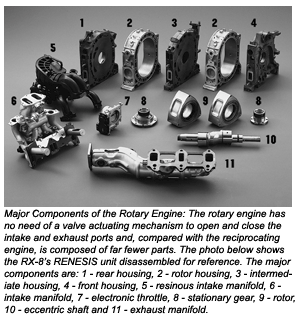 The inside space of the housing (or the trochoid chamber) is always divided into three working chambers. Due to the turning of the rotor, those three working chambers are always in motion and successively execute the four processes of intake, compression, ignition (combustion) and exhaust inside the trochoid chamber.
The inside space of the housing (or the trochoid chamber) is always divided into three working chambers. Due to the turning of the rotor, those three working chambers are always in motion and successively execute the four processes of intake, compression, ignition (combustion) and exhaust inside the trochoid chamber.
Each process is carried out in a different place in the trochoid chamber. This is significantly different from the reciprocating engine, where those four processes are carried out within each cylinder.
The displacement volume of the rotary engine is generally expressed by the unit chamber volume and by the number of rotors. For example, with the model 13B two-rotor rotary engine, the displacement volume is shown as “654cc °— 2”.
The unit chamber volume means the difference between the maximum volume and the minimum volume of a working chamber, while the compression ratio is defined as the ratio between the maximum volume and the minimum volume. The same definitions are used for the reciprocating engine.
Another difference is the turning angle per process. The reciprocating engine turns 180° while the rotary engine turns 270°, one-and-a-half times that of the reciprocating engine. In other words, in the reciprocating engine, the crankshaft (output shaft) makes two turns (720°) during the four processes, while in the rotary engine, the eccentric shaft (output shaft) makes three turns (1,080°) while the rotor makes one turn. In this way, the rotary engine has a longer process time, causes less torque fluctuation and results in smooth operation. Furthermore, even in high speed running, the rotor’s rpm is comparatively slower, thus, the more relaxed timing constraints of the intake and the exhaust processes facilitate the development of systems aimed at attaining higher performance.
Source: Mazda













